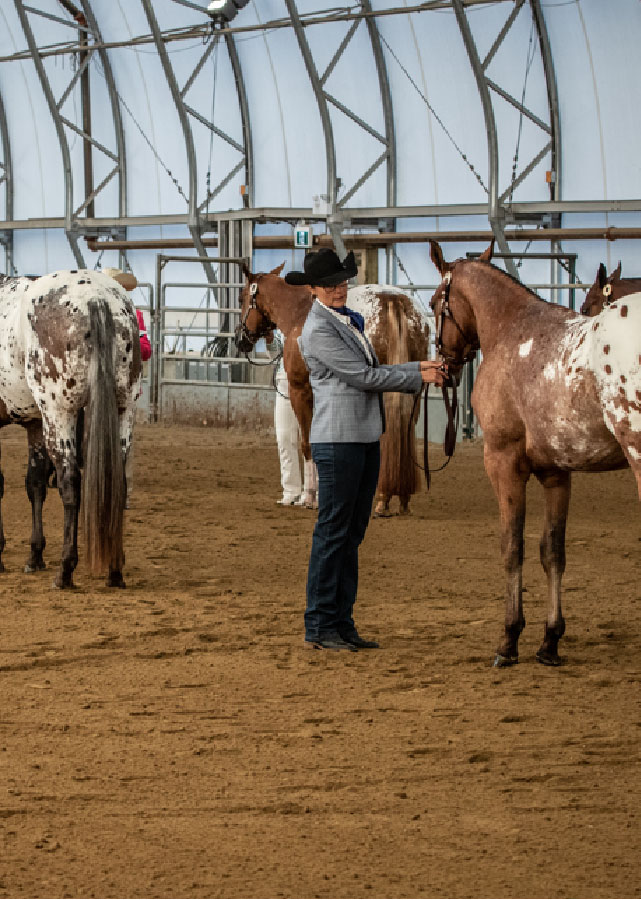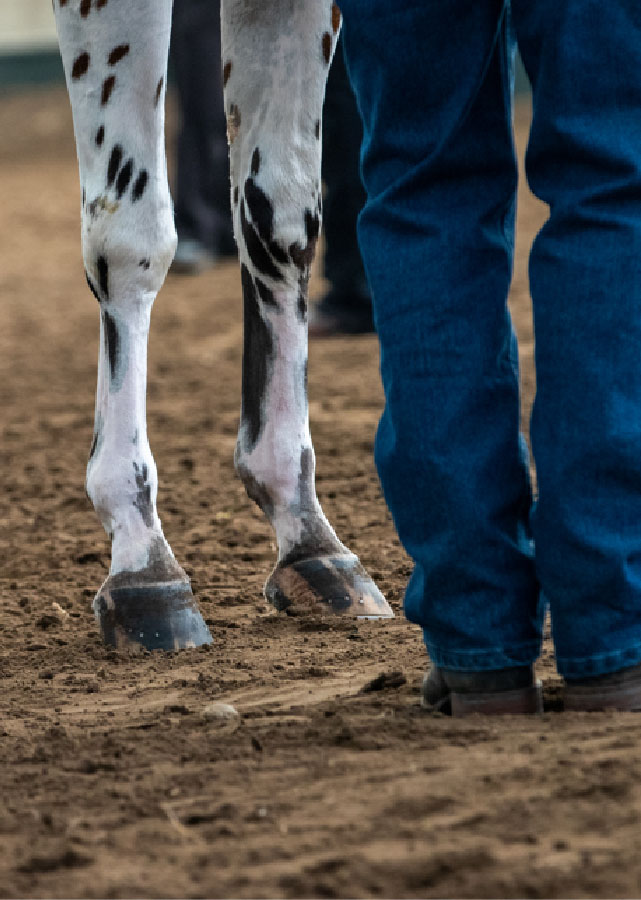Breed Information

Information about the Appaloosa breed
The Versatility of the Appaloosa
The Appaloosa is truly one of the most versatile horses of the light horse breeds with the disposition to make them a suitable mount for all level of riders. Appaloosas excel in upper levels of both the english and western disciplines – for example; Dressage, Hunter Under Saddle, Three Day Eventing, Endurance, Reining, Cutting, Working Cow Horse, Western Pleasure, Barrel Racing, and setting records on the race track. The Appaloosa is also a prized mount for pleasure trail riding and as a family horse.Coat patterns
The distinctive coat patterns of the Appaloosa are as unique and different as each horse’s personality is. Many Appaloosas may change from one pattern to another over their lifetime. There are eight (8) basic categories of Appaloosa coat patterns:
Blanket:
A solid white area normally over the hip area on a horse with a contrasting base color.
Blanket with Spots:
A white area normally over the hips with dark spots located within the white. The spots are usually the same color as the base color of the horse. However, a horse may also have more than one color of spots.
Leopard:
A white horse having dark spots over the entire body.
Roan:
An Appaloosa roan pattern is a mixture of white and dark hairs.
Roan Blanket:
A mixture of white and dark hairs usually over the hip area.
Roan Blanket with Spots:
A mixture of white and dark hairs over a portion of the body with white and/or dark spots within the roan area.
Spots:
A horse with white or dark spots over a portion of its body or over the entire body.
Solid:
A horse that has a base color with no contrasting color. Some Appaloosas may be a combination of more than one pattern.


Characteristics
An Appaloosa is also identified by three other characteristics – striped hooves, mottled skin, and white sclera around the eye.
Mottled Skin
Mottled skin is unique to the Appaloosa Horse. Therefore, mottled skin is a basic and decisive indicator of an Appaloosa. Mottled skin is different from commonly found pink (flesh-colored or non-pigmented) skin in that it normally contains dark areas of pigmented skin within its area. The result is a speckled or blotchy pattern of pigmented and non-pigmented skin. Usually found around the muzzle, eyes, and genitals.
Striped Hooves
This characteristic can be found on other breeds, but the stripes on an Appaloosa’s hoof have clearly defined vertical light and dark stripes, and can be found on both dark or white legs.
Sclera (white around the eye similar to a human eye)
The sclera is the area of the eye which encircles the cornea – the colored or pigmented portion. All horses have sclera but the Appaloosa’s is white and usually more readily visible than other breeds.
History
The Appaloosa Horse is a breed that has existed for centuries in the Old World. Evidence of spotted horses were found in prehistoric cave drawings. Archaeological and historical records show the ancient Chinese Emperors describing them as “heavenly horses”, and 17th and 18th century European aristocrats prized them highly as mounts. The modern history of the Appaloosa is intertwined with the history of the American Native Indian. Introduced to the New World by the Spanish Conquistadors, some of these spotted horses eventually made their way into the hands of the Native Americans. The Nez Perce and Palouse tribes of Washington, Oregon, and Idaho became the first to selectively breed these spotted horses in the New World. These horses were envied by all because of their strength, speed, and hardiness. The Nez Perce developed a tough, swift, and sure-footed mount to meet their needs. These same traits were of value to the early frontiersmen and were in high demand.
White settlers called these horses “Palouse Horses” because they were seen by the Palouse River or owned by Palouse Tribe. Over time, the name was slurred to “Palousey” and eventually to “Appaloosey”, then Appaloosa. Appaloosa Horses, during the Nez Perce War of 1877, helped Chief Joseph and his tribe to flee over 1300 miles of rugged land, and out maneuver the US army despite of the fact the tribe traveled with many women and children and mares heavy in foal. Only Chief Joseph’s mistaken belief that they had reached the safety of Canadian soil, led to their eventual defeat.
The surviving horses were either killed, or given to settlers with the stipulation that they must be bred to draft stock. This specification alone attests to the high regard the army had for the mounts of their adversary. Not until the 1930’s, when the Appaloosa was almost pushed to the brink of extinction, did some visionary horsemen try to preserve, revive, and improve the Appaloosa Horse. The Appaloosa Horse Club (ApHC) was formed, and is the international registry today. Today, the Appaloosa Horse continues to grow in popularity and is a prized mount for all areas of competition as well as a family horse.
